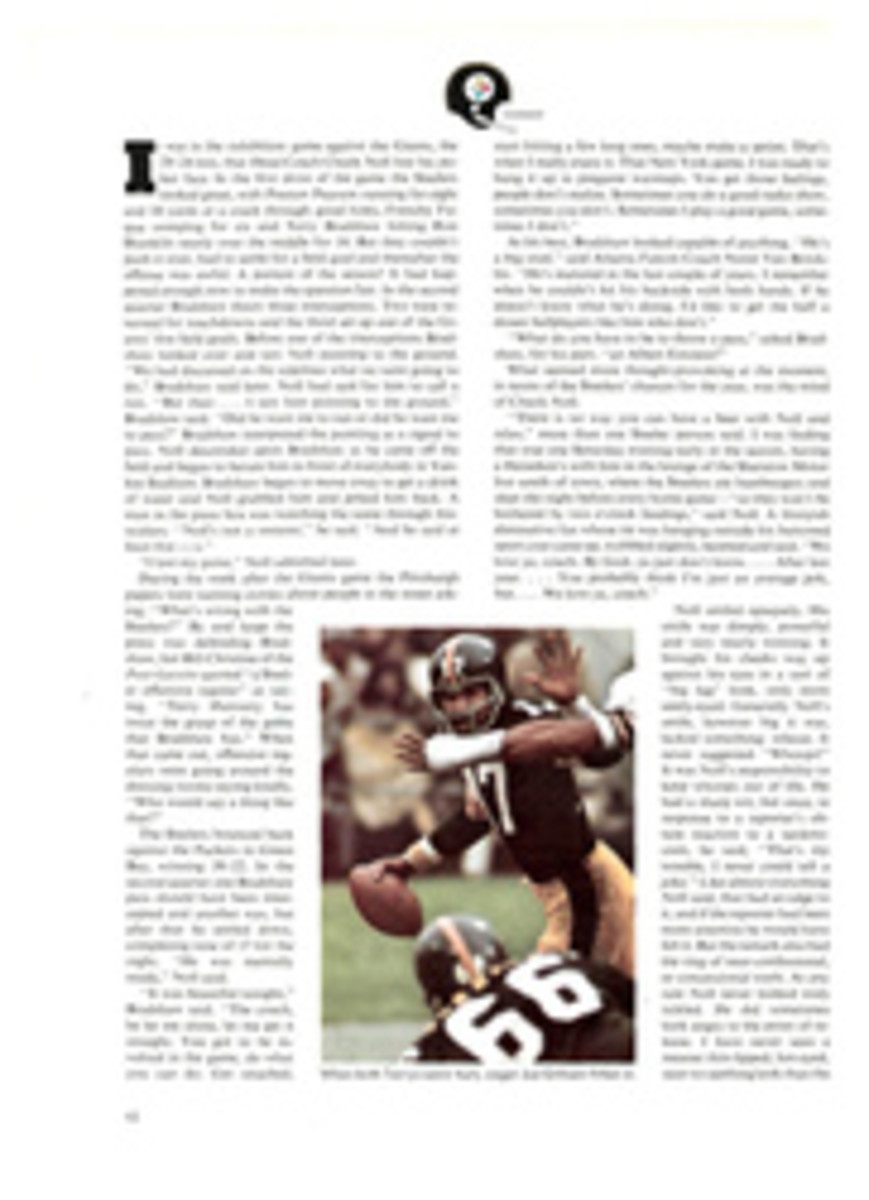
The flip that led to a flap
At the end of the long-jump runway, an athlete grimly surveyed his course, apparently convinced that a glowering look at the sand pit 150 feet away would induce a recess from gravity, if not the true meaning of life. He drew a deep breath, broke into his sprint down the runway, launched himself off the board and—Hey, look at that, Ethel!—did a full forward somersault before he landed.
Thus did John Delamere of Washington State earn a cheer for grit, as true as the sand he brushed off his palms. While he failed to qualify for the long-jump finals in the NCAA championships in Austin, Texas last month, his style was, by a long shot, the most eye-catching of the competition. The 22-year-old New Zealander had just demonstrated the flip, which is either the first significant long-jump breakthrough in more than 50 years or a spectacular way to break your neck.
Long jumpers have been bounding off into sand and sawdust since the earliest days of track and field competition, but not until this year did a sizable number alter the flight plan with the forward somersault. Those who have adopted it swear it is in a class with the Fosbury Flop and the fiber-glass pole and will produce the first 30-foot jump. Others say the flip is a fluke, but most coaches and athletes are undecided, waiting to vote one way or the other as performance, or injury, dictates.
Or the rules. Unless the 30-foot jump happens soon, the International Amateur Athletic Federation may render deliberation moot by voting to outlaw the flip in international competition when its technical committee meets in Rome next month. At an earlier IAAF meeting reservations were voiced about the technique.
"Some members of the committee." said U.S. delegate Pincus Sober, "felt that the method is so different that it is not the event traditionally known as the long jump." Asked why no similar action was proposed when the flop high jump appeared, Sober said soberly, "There was nothing we could do about the flop because it was in wide practice before we could do anything about it."
Whatever the disposition of the flap over the flip, the technique is not that new. The somersault long jump had been written about and discussed before the last Olympic Games by Tom Ecker, a coach and authority on biomechanics who is the flip's No. 1 advocate, if not its modern-day originator. Author of Track and Field Dynamics, Ecker says he never heard of the flip before 1970, when he wrote his book. Since its publication in 1971, however, he has talked to a coach who says he saw it performed in 1947 and has heard from another reader who claims to have seen it in 1925.
Ecker's advocacy engendered little response until last year, when Pole Vaulter Dave Nielsen, a student at the University of Iowa, took up the somersault long jump for fun. A Swedish-born American citizen who had never been more than a mediocre long jumper, Nielsen improved his conventional best by a foot to 22'6" with the flip. At a meet in Stockholm he demonstrated the technique for Hans Lagerqvist, the Swedish vaulter, who later enlightened the Germans, among others, by demonstrating the flip over television. Shortly thereafter, 32-year-old Bernhard Stierle of West Germany adopted the technique, flipped 7.5 meters (24'7¼") and somehow was credited with inventing the thing.
While others may have tried the flip before the '70s or gained more recent notoriety with its use, Ecker was the first to explain its technical advantages through the laws of physics. Ecker claims the flip has undeniable dynamic advantages over conventional jumping, not the least of which is reduced wind resistance, because of the compact manner in which the jumper tucks his body together. The biggest plus, however, is that the flipper utilizes forward body rotation, while rotation is what most hinders the "normal" jumper.
Whether he knows it or not, once the conventional jumper leaves the board, he is fighting "the principle of the hinged moment," which sounds like a daytime TV serial but is a physical law. It says that when any object is moving and one end of it is stopped, the opposite end continues moving at an accelerated rate to produce rotation. Because a long jumper's foot is stopped on the board for about .12 seconds while his upper body is still moving, the forward rotation will dump the juniper on his face unless he compensates with the hitch kick, the hang, or some other counteracting body movement. Even with those techniques, which are difficult to learn, rotation is diminished only temporarily.
Trouble enough in the air, rotation presents a greater problem when the conventional jumper lands. At the precise moment when he wants his feet as far ahead of his body as possible, forward rotation may make his heels trail his body and thus hit the sand prematurely.
In contrast, Ecker points out that the flip enables the jumper to take off from the board almost at full speed and at a more desirable higher angle. When he tucks and rolls into a somersault, wind resistance is cut. And since rotation is working with him rather than against him, his feet will land—assuming correct execution—well ahead of his body, and the latter should follow on through so that he does not fall back in the pit. In practice, the hardest part of the new technique to learn is landing. "Wiping out in the flip," Delamere says painfully, "is coming down butt first." To preclude that dire end, the East Germans reportedly have theorized that a half-twist should be added to the flip so that the jumper lands facing the board.
Few things in sport prove as easy in competition as on paper, and the flip is no exception. While the dynamics of the new technique may satisfy the laws of physics, the danger factor is at least a worrisome possibility. A flip long jumper is not going to land in a foam-rubber pit, as does a flop high jumper or a fiberglass pole vaulter. What if he hesitates a moment too long before going into his tuck? What if his ankle gives slightly as he takes off from the board? What about the "fear factor"—getting up enough nerve to try the flip the first time?
Both Ecker and the jumpers using the flip deny it is dangerous. "I don't think there's any danger at all," Ecker says. "About the worst a guy could do would be to land on his behind. As for fear, it's like the pole vault. You'd never get me to hang upside down 18 feet up in the air on a bent pole, yet there are kids who do it with no trouble at all."
Washington State's assistant track coach, Rick Sloan, who taught himself the flip in order to coach it, says, "It is a frightening experience that first time. Jumping conventionally, you can see where you're going. With the flip, you're blind through most of the jump. You see a little grass, a little sky and no sand until the very end. But I can't imagine how you could mess it up so badly that you'd land on your neck, if you practice it first on the soft pads of a pole-vault pit. I don't think it's as dangerous as the flop. Remember the talk about kids breaking their necks when that first started?"
At the NCAA meet, the flu made a flop of Delamere's flip but in the Pacific-8 Conference meet three weeks earlier he somersaulted 25'6¾" to tie the Olympic champion, USC's Randy Williams. Observing the unorthodox technique of his rival, Williams said, "I like it. He's relaxing at the top of his jump. While we're working for every extra little bit, he's just worried about landing."
Delamere is a 6'2", 166-pound senior who has run 100 meters in 10.7 and, by his own admission, is no great tumbler. "I had never tried a somersault before this," he says. "I've never even tried one off a diving board into a swimming pool. I'd be too scared."
Delamere is convinced that his potential with the flip is much greater than his personal best (a wind-aided 25'9½") using the customary style. "I'm sure I can go 28 feet with it," he says. "When I'm 100% healthy, my takeoff is O.K. I've got to perfect my landing. No one really paid attention to this thing until now because the guys who had been experimenting with it weren't very good jumpers to begin with. I'm the first genuine long jumper who's tried it. I think I can go a lot farther with it, and others can do even better. What you need is a guy with 9.5 speed and good gymnastics ability."
Because of its potential, the flip is claiming more converts all the time. From the mail he has received asking for information, Ecker estimates that hundreds of jumpers are now flipping, most at the high school level. Even decathlon men have taken to it.
Whatever its ultimate fate, there is no denying that the flip is more fun to watch, and that the long jump, often one of the least-noticed events in track and field, could become one of the most popular. All that seems needed now is for a few top jumpers to adopt the technique, skill themselves in it and win, say, an Olympic gold medal. When that happens, a lot of coaches will be advising their young jumpers to go take a flying flip.
FIVE ILLUSTRATIONS
DONALD MOSS
THE FLIPPER takes off faster and at a higher angle, tucks to cut wind resistance and uses rotation to carry him farther, while the conventional jumper has to fight both air and foot drag.

